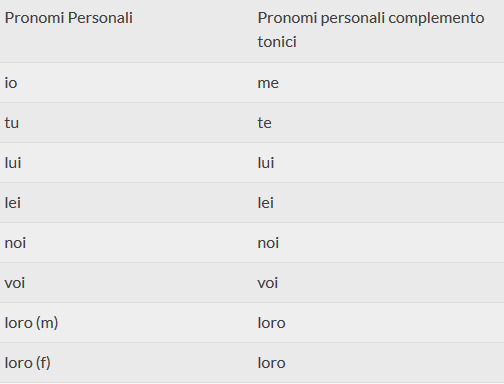
In this page we will talk about direct pronouns, indirect pronouns, and how to merge them together into a combined pronoun. They are very easy to use and, once you have understood the mechanism, you can be sure about how to form them.
Let’s look at the differences between these types of pronouns:
Direct pronouns in Italian
Direct pronouns, as the name implies, are used to substitute a direct object (answering the question: whom? what?):

(What do I drink? The cappuccino; Whom did I meet? Michela)
This table presents the personal pronouns and the corresponding direct pronouns:

Sometimes it may be necessary to substitute an entire sentence. In this case, use the third person singular masculine direct pronoun: lo
(“lo” stands for the whole sentence: I don’t know “what time it is”).
As we already know, the polite formula form in Italian is made by using the third person singular feminine. It’s the same in the case of direct pronouns:
(“La” stands for the Lady whom I am thanking. In English you would use “you”).
Direct pronouns are generally used before the verb:
An exception to the rule: When you are using a modal verb (want/can/must…) or a phrasal verb followed by a verb in the infinitive form (-are, -ere, -ire) you can choose whether to put the pronoun before the verb or to bundle it together with the infinitive form by dropping the last lettere of the verb:

Indirect pronouns in Italian
Indirect pronouns, instead, substitute an indirect object preceded by the preposition “a”:
![]() (“mi” instead of “a me”)
(“mi” instead of “a me”)
These are the indirect pronouns in Italian:

The only problem with indirect pronouns is found when using the third person plural. Here we have two possibilities:
- Use “gli” and put it before the verb:

- Use “loro”, but remember to put it after the verb:

We suggest that you choose one of the two forms and stick to it, at least at the beginning!
As you already know, the polite form in Italian is rendered with the third person singular feminine. It’s the same with indirect pronouns:
![]()
Indirect pronouns are generally used before the verb:

An exception to the rule: As for the direct pronouns, when you are using a modal verb (want/can/must…) or a phrasal verb followed by a verb in the infinitive form (-are, -ere, -ire) you can choose whether to put the pronoun before the verb or to bundle it together with the infinitive form by dropping the last lettere of the verb:

Combined pronouns in Italian
What are combined pronouns? Very simple: they are the combination between an indirect pronoun and a direct pronoun. Here are a series of rules to form them without any doubts:
- The pronouns mi, ti, ci and vi change the vowel: i becomes e
- When the third person singular or plural indirect pronoun GLI combines with a third person singular or plural direct pronoun, rember to:
- Add an E between the indirect and the direct pronoun
- Join the words into a single one
Look at the table below to understand the simple mechanism used to form combined pronouns in Italian:
The other rules that we have seen applied to direct and indirect pronouns are also valid in the case of combined pronouns
Tonic and atonic personal pronouns
The direct and indirect pronouns that we have looked at until now are called atonic pronouns: that is, pronouns that do not have a tonic accent. Personal pronouns used as a complement, both direct and indirect complement, however, can also be tonic: that is, having their own accent.
Here they are:

As already mentioned, tonic personal pronouns can be used as:
- direct complement: they normally follow the verb, without a preposition

- Indirect complement: they can either precede or follow the verb, and they are introduced by various prepositions:

See also:
- Exercises on the pronouns
- A song to learn more about the pronouns
- A text for the comprehension of pronouns in Italian
- A video to supplement the text